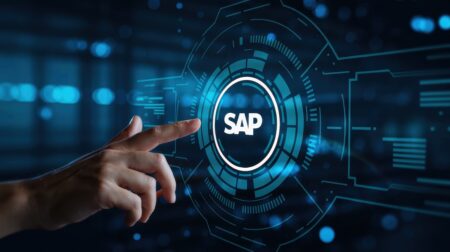On the heels of Azure’s 76% revenue surge in Q4, Microsoft is seeing a “huge pipeline” for mission-critical SAP apps moving to Azure, along with triple-digit growth in its data-services business and strong ongoing demand for its hybrid-cloud offerings.
As SAP pushes all of its customers to move by 2025 into the cloud with its HANA platform, “We see a phenomenal pipeline around SAP systems moving to Azure,” said Microsoft corporate VP for Azure marketing Julia White at the recent Goldman Sachs investors conference.

White said the SAP push to HANA is part of a sweeping move among businesses to migrate apps and workloads to the cloud to take full advantage of the cloud’s economic benefits, its shorter time to value, and its faster path to innovation.
“The migration pipe is as good as the innovation pipe, and we’ve kind of normalized on that because of the types of workloads,” White said.
“And then within the migration you’re seeing things like SAP—and it’s a huge pipeline—mission-critical systems running on Azure.”
The SAP-on-Azure Phenomenon: The “Huge Pipeline”
I’m fascinated by White’s comments about the “huge” and “phenomenal” pipeline for moving mission-critical SAP workloads and applications over to Azure. Two reasons for that reaction: first, it’s a clear indication that hundreds and perhaps thousands of large businesses around the world have become so comfortable with the cloud that they’re now fully comfortable putting their most-essential production systems in the cloud via Azure.
And second, it’s also the most-powerful endorsement Microsoft could hope to get regarding Azure’s ability to handle some of the world’s biggest, most-complex and—yeah, let’s say it one more time to be sure it sinks in—mission-critical workloads.
Late last year, as I began hearing more and more frequently about this SAP-on-Azure phenomenon, I asked Microsoft a series of questions about these massive migrations: what types of companies, how big, how long does it take, etc. And here’s some of the feedback I received from Microsoft corporate VP for Azure Girish Bablani, with my questions in boldface followed by Bablani’s replies sent via email.
What types of workloads? And in what industries?
“In terms of migration, a lot of these are from legacy NetWeaver-based applications like Business Suite, CRM, SCM, etc. on mostly Oracle, SQL Server, Db2, maxDB or SAP ASE. We also see some migration of HANA as well. In addition we see lots of customers deploying greenfield implementations of S/4HANA. The customers are spread across all industries. We have globally operating mining companies, airlines, high-tech industry, retail, agriculture industries, etc. An example of a migration is Accenture, which moved its 7TB SAP Hana BW estate from a legacy implementation, and an example of a greenfield implementation is Daimler AG, who did a greenfield S/4HANA implementation on Azure.”
How big are the workloads in these migrations?
“Our customers are running SAP workloads in all sizes. There is a substantial number of larger SAP HANA implementations because of our HANA Large Instance (Bare Metal) offering which supports up to 20TB configuration and TDI v5 configurations of up to 24TB.
“For example, customers like Rio Tinto and Microsoft with SAP Business Suite (ERP) are between 10TB and 16TB using SQL Server. While the database size is a key factor in how we define big, it’s the overall landscape that customers are moving to Azure that is impressive. Rio Tinto has one of the largest implementations of SAP in any public cloud, spanning sandbox, development/testing, quality assurance, pre-production, and production environments. Its SAP estate—which is vital for the company’s enterprise resource planning, financial management, business intelligence, and many other functions—uses two Azure datacenters in Australia with more than 1,000 Azure Virtual Machines, hundreds of virtual networks, and a petabyte of Azure Storage.”
What advantages are those corporations gaining from move to Azure?
Bablani outlined four key advantages: freedom from having to buy and operate hardware; the elasticity of the cloud; engineering agility; and the ability to accelerate digital transformations.
- “The simplest advantage is freedom from having to buy and operate the hardware. As you know, SAP is encouraging customers to move to S/4 Hana as part of their digital transformation. However a customer may not be quite ready in terms of business process migration and has to “early bind” to their hardware if they stay on premise. By moving to Azure, they can optimize the hardware they run on and scale up or down depending on their software and systems roadmap. This also applies to scaling up as their database grows – Azure offers the flexibility to move up and down VM sizes as well as HANA large instances and very large instances.”
- Another advantage is the elasticity of the cloud. Almost all customers run staging, dev/test, functional testing and pre-production instances of SAP. Azure can help create these environments on demand and scale them up and down and potentially even shut some of them down at night or weekends. Accenture is a good example for this cost savings. The reduced uptime schedules for non-production environments as well as not buying hardware for contingencies led to real cost savings for them because they only pay for what they use. Similarly, Rio Tinto was able to save 30% of its IT operating cost because by running SAP running in Azure they vacated four datacenters—two production and two disaster recovery facilities.”
- “Engineering agility also improves by moving to Azure. Customers take advantage of continuous integration and other modern engineering practices using the rich set of dev-ops tools available in Azure to increase their engineering agility and innovation. I mentioned Daimler earlier. They have moved their procurement system, called NPS, to Azure. Their previous system could be updated only a couple of times a year. Now, running in Azure, they can issue updates every day if necessary.”
- “But perhaps the most important benefit is being able to accelerate the customer’s digital transformation. Once their core SAP systems and business-critical systems are in the cloud, they can integrate the systems with Office 365, Azure Active Directory for identity and authorization, and take advantage of large-scale analytics, machine learning, IoT and all the benefits that Azure and the SAP Cloud Platform offer. Rio Tinto, for example, used SAP in Azure to move to a data-centric foundation. They increased efficiency and innovation by collecting and analyzing real-time data from smart drills, trucks and blast systems. They are working on developing a connected mine solution using IoT driven functionality. Again—all of this acceleration stemmed from the initial movement of the SAP mission-critical systems to Azure and then integrating with PaaS and SaaS services available in the cloud.”
What types of environments are they moving away from: Oracle databases? On-premises systems? Other cloud vendors?
“We see customers mostly moving from on-premises systems and managed private-hosting providers. There are some cases where customers moved from other clouds, mostly AWS and Virtustream. In terms of databases and OS we see different tendencies, such as:
- “A lot of customers choose to stay with their existing database systems—they are just doing a lift and shift.
- “Customers moving from AIX, Solaris, HP-UX often change their Oracle or DB2 database to SQL Server. Some of those customers use the opportunity to move to Linux but still keep their database systems. Some of course use this opportunity to move their NetWeaver-based SAP application to HANA.
- “There is a smaller set of customers who move their NetWeaver SAP application that runs on HANA into Azure. The motivation is usually that their on-premises hardware appliance is going out of service or the memory demand of HANA is outgrowing their hardware. In such cases, Azure’s scale-up solutions of HANA 20TB gives them a lot of headroom.”
Timing of these migrations: How many months?
“The timing depends heavily on the number of systems, size of the systems, surrounding applications, interfaces into the SAP applications, and ultimately what the customer wants to achieve. We have had customers go live in production within 3 months of starting, to migrations that are staged over 12 months.”
(Disclosure: At the time of this writing, Microsoft was a client of Evans Strategic Communications LLC.)
Subscribe to the Cloud Wars Newsletter for twice-monthly in-depth analysis of the major cloud vendors from the perspective of business customers. It’s free, it’s exclusive, and it’s great!
*******************
RECOMMENDED READING FROM CLOUD WARS:
The World’s Top 5 Cloud-Computing Suppliers: #1 Microsoft, #2 Amazon, #3 Salesforce, #4 SAP, #5 IBM
Amazon Versus Oracle: The Battle for Cloud Database Leadership
As Amazon Battles with Retailers, Microsoft Leads Them into the Cloud
Why Microsoft Is #1 in the Cloud: 10 Key Insights
SAP’s Stunning Transformation: Qualtrics Already “Crown Jewel of Company”
Watch Out, Microsoft and Amazon: Google Cloud CEO Thomas Kurian Plans To Be #1
The Coming Hybrid Wave: Where Do Microsoft, IBM and Amazon Stand? (Part 1 of 2)
Oracle, SAP and Workday Driving Red-Hot Cloud ERP Growth Into 2019
*********************








